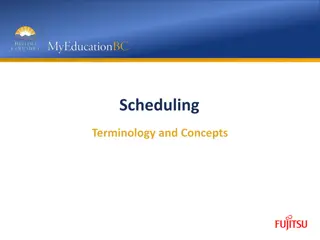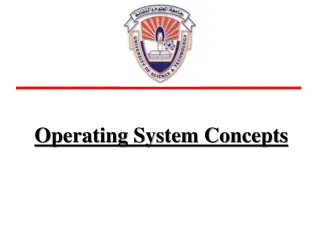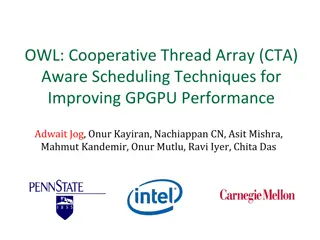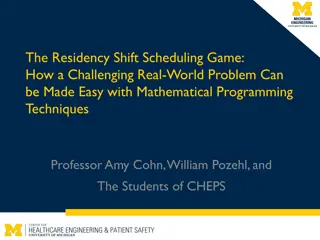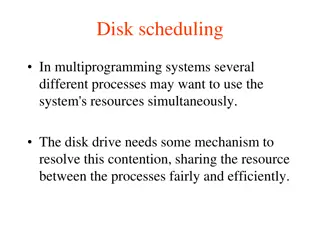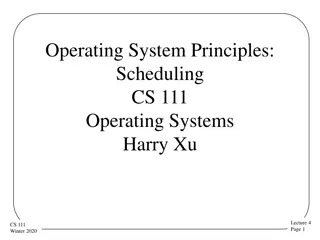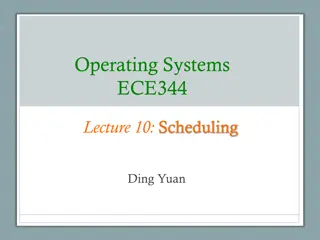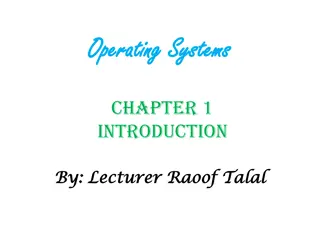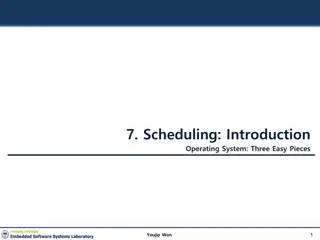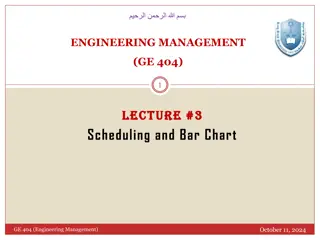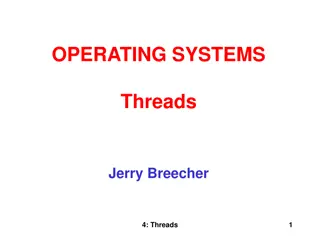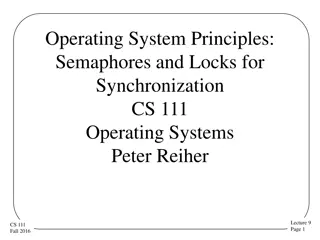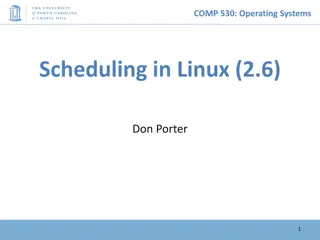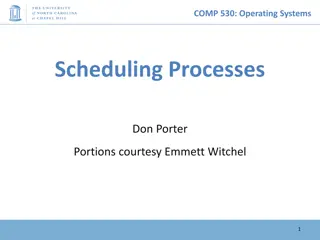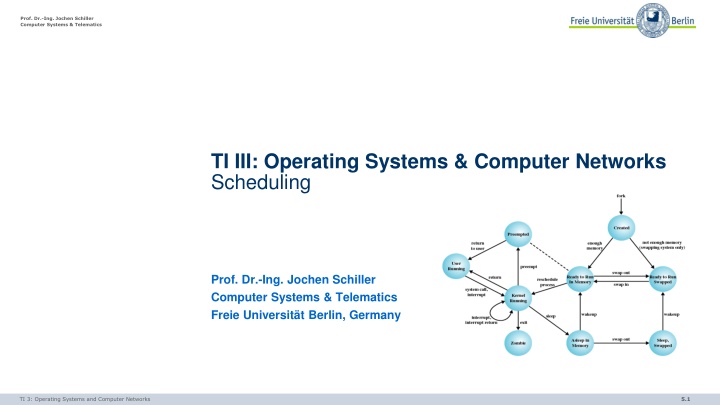
Understanding Operating System Scheduling
In this detailed exploration, delve into the various aspects of operating system scheduling, including processes, memory, I/O, file systems, and more. Learn about process states, types of scheduling, goals, and decision-making involved in efficiently managing resources. Gain insights into how scheduling impacts throughput, response time, and processor efficiency, with a focus on achieving optimal utilization and fairness in resource allocation.
Download Presentation

Please find below an Image/Link to download the presentation.
The content on the website is provided AS IS for your information and personal use only. It may not be sold, licensed, or shared on other websites without obtaining consent from the author. If you encounter any issues during the download, it is possible that the publisher has removed the file from their server.
You are allowed to download the files provided on this website for personal or commercial use, subject to the condition that they are used lawfully. All files are the property of their respective owners.
The content on the website is provided AS IS for your information and personal use only. It may not be sold, licensed, or shared on other websites without obtaining consent from the author.
E N D
Presentation Transcript
Prof. Dr.-Ing. Jochen Schiller Computer Systems & Telematics TI III: Operating Systems & Computer Networks Scheduling Prof. Dr.-Ing. Jochen Schiller Computer Systems & Telematics Freie Universit t Berlin, Germany TI 3: Operating Systems and Computer Networks 5.1
Content 1. Introduction and Motivation 2. Subsystems, Interrupts and System Calls 3. Processes 4. Memory 5. Scheduling 6. I/O and File System 7. Booting, Services, and Security TI 3: Operating Systems and Computer Networks 5.2
Definition and Goals Assign processes to be executed by the processor(s) More general: Assign consumers to resources -Examples: I/O requests Device-specific queues -Memory pages Primary/secondary memory Goals: -Throughput, i.e., effectively use processing time -Response time / fairness, i.e., interactivity of individual processes -Processor efficiency, i.e., optimal utilization of CPU (as resource) Conflicting goals: Maximal throughput means unpredictable response time (and vice versa) TI 3: Operating Systems and Computer Networks 5.3
Process States and Scheduling Scheduling decisions correspond to state transitions in process state graph TI 3: Operating Systems and Computer Networks 5.4
Process States and Scheduling Scheduling decisions correspond to state transitions in process state graph -States form hierarchy depending on transition frequency TI 3: Operating Systems and Computer Networks 5.5
Types of Scheduling Long-term scheduling Whether to add process to running queue and execute it - Determines which programs are admitted to system for processing, e.g., based on user - Specifies degree of multiprogramming, i.e., maximal number of processes - The more processes, the smaller percentage of time each process is executed How many processes should be allowed? TI 3: Operating Systems and Computer Networks 5.6
Types of Scheduling Medium-term scheduling Whether to add/remove existing process (that is only partially in primary memory) - Part of swapping function - Based on need to dynamically manage degree of multiprogramming (considering available resources) Should processes be swapped in or out? If so, which ones? TI 3: Operating Systems and Computer Networks 5.7
Types of Scheduling Short-term scheduling Which one of fully available processes to run - Known as dispatcher - Executes most frequently Overhead / algorithmic complexity matters - Invoked when event occurs (clock interrupts, I/O interrupts, operating system calls, signals) Whose turn is it? TI 3: Operating Systems and Computer Networks 5.8
Types of Scheduling I/O scheduling Which I/O request (of which process) to dispatch to I/O device for handling Consider state of external device TI 3: Operating Systems and Computer Networks 5.9
Short-Term Scheduling Criteria User-oriented: -Response time: elapsed time between submission of a request until there is output Interactivity: user perceives system as responsive Performance-related: -Quantitative / measurable properties -Examples: response time, throughput Non-functional: -Algorithmic properties -Examples: predictability, fairness System-oriented (hardware and resources): -Effective and efficient utilization of processor Performance-related Non-functional Turnaround time Response time Deadlines Predictability User-oriented Throughput Processor utilization Fairness Enforcing priorities Balancing resources System-oriented TI 3: Operating Systems and Computer Networks 5.10
Scheduler Implementation: Queuing TI 3: Operating Systems and Computer Networks 5.11
Questions & Tasks -Compare a TOP500 high-performance compute cluster with a standard PC, an on-board flight stabilization controller and a game console when it comes to scheduling. What are typical long, mid and short term tasks? Where should the focus be in system design in terms of throughput, response time, fairness, efficiency? -What does a perfect scheduling system need? (OK, it does not exist, but in theory ) TI III - Operating Systems and Computer Networks 5.12
Scheduling Decision Modes Non-preemptive -Current process explicitly yields CPU Cooperative multitasking, e.g., Windows (<95), Mac OS (<X) -Once a process is in running state, it will continue until it terminates or blocks itself for I/O Preemptive -OS may interrupt current process -Transparent to process Preemptive multitasking, e.g., Windows ( 95), Mac OS X, Unix -Allows for better scheduling since no process can monopolize CPU TI 3: Operating Systems and Computer Networks 5.13
Priorities Some processes are more important than other processes, i.e., should get more CPU cycles or better responsiveness than others -Similar for other resources Scheduling is controlled by per-process priorities -OS internal vs. user-visible priorities Scheduler will always choose a process of higher priority over one of lower priority Lower-priority processes may suffer starvation, i.e. are never scheduled and do not make any progress TI 3: Operating Systems and Computer Networks 5.14
Priority Implementation: Queuing Have multiple ready queues to represent each level of priority Move process data between queues according to scheduling algorithm TI 3: Operating Systems and Computer Networks 5.15
blocked by T3 (attempt to lock s) s locked T1 Priority Inversion and Inheritance T2 preempted by T1 preempted by T2 s unlocked s locked Problem: Priority Inversion Occurs when circumstances within the system force a higher priority task (here: T1) to wait for a lower priority task (here: T2) Solution: Priority Inheritance Lower-priority task (here: T3) inherits priority of any higher priority task (here: T1) pending on a resource they share T3 t1 t2 t3 t4 t5 t6 t7 t8 time (a) Unbounded priority inversion s locked by T1 blocked by T3 (attempt to lock s) blocked by T3 (attempt to lock s) s unlocked s locked T1 T1 T2 T2 preempted by T1 s locked by T3 s unlocked preempted by T1 preempted by T2 s unlocked s locked T3 T3 t1 t2 t3 t4 t5 t6 t7 t1 t2 t3 t4 t5 t6 t7 t8 (b) Use of priority inheritance time normal execution execution in critical section (a) Unbounded priority inversion TI 3: Operating Systems and Computer Networks 5.16 s locked by T1 Figure 10.9 Priority Inversion blocked by T3 (attempt to lock s) s unlocked T1 T2 preempted by T1 s locked by T3 s unlocked T3 t1 t2 t3 t4 t5 t6 t7 (b) Use of priority inheritance normal execution execution in critical section Figure 10.9 Priority Inversion
Questions & Tasks -What are prerequisites for preemptive scheduling? Who preempts and how can this work if a process does not want to leave the processor? -Is preemptive scheduling really transparent to processes? -What are typical low-priority or high-priority processes, respectively? -Go through the example for priority inversion/inheritance and try to understand it! Do you find an example in everyday life? TI III - Operating Systems and Computer Networks 5.17
Scheduling Algorithm Classes Non-preemptive - First-Come-First-Served (FCFS) - Shortest Process Next (SPN) - Highest Response Ratio Next (HRRN) Preemptive - Shortest Remaining Time (SRT) - Round-Robin - Feedback Example workload TI 3: Operating Systems and Computer Networks 5.18
First-Come-First-Served (FCFS) New process placed at end of Ready queue When current process ceases to execute, oldest process in the Ready queue is selected Short process may have to wait a very long time before it can execute Poor response time / interactivity Favors CPU-bound processes -I/O processes have to wait until CPU-bound process completes, since I/O processes frequently call into OS TI 3: Operating Systems and Computer Networks 5.19
Shortest Process Next (SPN) Process with shortest expected processing time is selected -OS may abort processes with incorrect time estimates Short processes jump ahead of longer processes Improves interactivity (based on assumption that short processes are due to user interaction) Predictability of longer processes is reduced Possibility of starvation for longer processes TI 3: Operating Systems and Computer Networks 5.20
Highest Response Ratio Next (HRRN) Choose next process with the highest ratio time spent waiting + expected service time expected service time Even long process will run eventually Generally, predictable response times not feasible without preemption TI 3: Operating Systems and Computer Networks 5.21
Shortest Remaining Time (SRT) Ready queue is sorted by remaining processing time -Requires estimate of remaining processing time New processes may preempt current process upon arrival -Preemptive version of shortest process next policy Improved response time of short processes by using preemption -Limited additional overhead due to process switches upon process creation But what happens to interactive requests that don t spawn a new process? TI 3: Operating Systems and Computer Networks 5.22
Round-Robin Each process may use CPU for given amount of time -Process preemption based on clock interrupt generated at periodic intervals, i.e., time slicing -Time quantum q as tunable parameter When interrupt occurs, currently running process is placed in Ready queue, next ready job is selected Initial support for interactivity Scheduling overhead (scheduling decision, process switch) Tradeoff between interactivity and efficiency, directly tunable by q Problematic for I/O processes that hardly ever use full quantum TI 3: Operating Systems and Computer Networks 5.23
Feedback Processes start in the queue with highest priority RQ0and move to queues with lower priority after each time slice -Multiple queues with different priorities For fairness, allow longer time slices q for queues RQi Penalize long running processes No need to know remaining execution time of process TI 3: Operating Systems and Computer Networks 5.24
Qualitative Comparison of Policies w = time spent waiting, e = time spent in execution so far, s = total service time required by process, including e TI 3: Operating Systems and Computer Networks 5.25
Quantitative Comparison of Policies TI 3: Operating Systems and Computer Networks 5.26
Questions & Tasks -Which scheduler is good for long jobs, gaming console, guaranteed processing time, normal PC, elevator controller, mobile phone? Why? (and remember: it depends ) -Go through the comparison table and try to understand the figures (e.g. what does Trmean?)! Is there a winner? TI III - Operating Systems and Computer Networks 5.27
MULTIPROCESSOR AND REAL-TIME SCHEDULING TI 3: Operating Systems and Computer Networks 5.28
Multiprocessor Scheduling Assignment of processes to processors -Permanently assign process to a processor -Treat processors as a pooled resource and assign process to processors on demand -Possibly move running process between processors (expensive!) Architectures -Global queue: schedule to any available processor -Master/slave: Key kernel functions always run on a particular processor, master is responsible for scheduling -Peer: Operating system can execute on any processor, each processor does self-scheduling Use of multiprogramming on individual processors Actual dispatching of processes TI 3: Operating Systems and Computer Networks 5.29
Real-Time Scheduling Correctness of system depends -on logical result of the computation -AND on time at which the results are produced Tasks or processes attempt to control or react to events that take place in outside world Examples: -Control of laboratory experiments -Process control in industrial plants -Robotics -Air traffic control -Telecommunications -Military command and control systems Real-time applications are not (that much) concerned with speed but with completing tasks TI 3: Operating Systems and Computer Networks 5.30
Real-Time Scheduling: Examples B1 B2 deadline deadline A1 A2 A3 A4 A5 deadline deadline deadline deadline deadline A1 A2 A3 A4 A5 Arrival times, execution times, and deadlines B1 B2 0 10 20 30 40 50 60 70 80 90 100 Time(ms) A1 B1 A2 B1 A3 B2 A4 B2 A5 B2 Fixed-priority scheduling; A has priority A1 A2 B1 A3 A4 A5, B2 (missed) A2 A3 A5 B1 B2 Fixed-priority scheduling; B has priority A1 A2 B1 A3 A4 A5, B2 (missed) (missed) A1 B1 A2 B1 A3 B2 A4 A5 B2 Earliest deadline scheduling using completion deadlines A1 A2 B1 A3 A4 A5, B2 TI 3: Operating Systems and Computer Networks 5.31 Figure 10.5 Scheduling of Periodic Real-time Tasks with Completion Deadlines (based on Table 10.2)
Questions & Tasks -Do you use real-time operating systems in your everyday life? -And what about multiprocessor scheduling? -Why is it expensive to move a process from one processor to another? -What happens if a process announces a wrong deadline or has an infinite loop in RT-scheduling? What can the OS do? TI III - Operating Systems and Computer Networks 5.32
Examples: Traditional UNIX Scheduling Multilevel feedback using round robin within each priority queue If running process does not block or complete within one second, it is preempted Priorities are recomputed once per second Base priority (set upon process creation) divides all processes into fixed bands of priority levels TI 3: Operating Systems and Computer Networks 5.33
Examples: UNIX SVR4 Scheduling Preemptable static priority scheduler SVR4 Priority Classes: -Real time (159 100) -Kernel (99 60) -Time-shared (59-0) Introduces set of 160 priority levels divided into three priority classes -Highest preference to real-time processes -Next-highest to kernel-mode processes -Lowest preference to other user-mode processes In-kernel preemption points, i.e. long running kernel operations may be preempted TI 3: Operating Systems and Computer Networks 5.34
Examples: Windows Scheduling Priorities organized into two bands or classes -Real time -Variable Priority-driven preemptive scheduler within each class TI 3: Operating Systems and Computer Networks 5.35
Example: Linux O(1) Scheduling Scheduling algorithm needs to scale with number of processes -Variable overhead unacceptable for real-time systems Linux O(1) scheduler -Active/expired bit arrays for priorities; one list per priority -Priority assigned based on - Static (process) priority - Heuristics to determine interactivity requirements, e.g. CPU- vs. I/O-bound -Process timeslice (i.e. runtime in relation to other processes) calculated when process moves from active to expired state -Switch from active to expired bit array when all processes have used their timeslice Scheduling decision in constant time TI 3: Operating Systems and Computer Networks 5.36
Related System Calls (Linux) int sched_yield(void) -Voluntarily yield processor, e.g. when waiting for input int getpriority(int which, int who) int setpriority(int which, int who, int prio) -Get/set priority of user, group or process (which) with ID who -Library interface: int nice(int inc) - Increment how nice you are; only root is allow not to be nice int sched_get_priority_max(int policy) int sched_get_priority_min(int policy) -Returns max/min priority values for given scheduling policy TI 3: Operating Systems and Computer Networks 5.37
Related System Calls (Linux, cont.) int sched_setscheduler(pid_t pid, int policy, conststruct sched_param *param) int sched_getscheduler(pid_t pid) -Controls which scheduling policy to use for a process -Policies are SCHED_BATCH, SCHED_FIFO, SCHED_RR and SCHED_OTHER int sched_setparam(pid_t pid, const struct sched_param *param) int sched_getparam(pid_t pid, struct sched_param *param) -Get/set policy specific scheduling parameters int sched_setaffinity(pid_t pid, unsigned int cpusetsize, cpu_set_t *mask) int sched_getaffinity(pid_t pid, unsigned int cpusetsize, cpu_set_t *mask) -Controls on which CPU in multi-processor system a process can/should run TI 3: Operating Systems and Computer Networks 5.38
Content 1. Introduction and Motivation 2. Subsystems, Interrupts and System Calls 3. Processes 4. Memory 5. Scheduling 6. I/O and File System 7. Booting, Services, and Security TI 3: Operating Systems and Computer Networks 5.39

